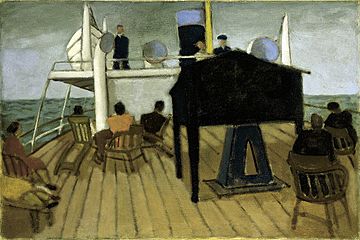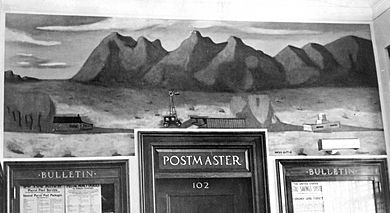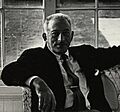Adolph Gottlieb facts for kids
Quick facts for kids
Adolph Gottlieb
|
|
|---|---|

Adolph Gottlieb in East Hampton
|
|
| Born | March 14, 1903 New York City, New York, U.S.
|
| Died | March 4, 1974 (aged 70) New York City, New York, U.S.
|
| Nationality | American |
| Education | Art Students League of New York, Académie de la Grande Chaumière, Parsons School of Design, Cooper Union |
| Known for | Painting, sculpture |
| Movement | Abstract expressionist |
Adolph Gottlieb (born March 14, 1903 – died March 4, 1974) was an American artist. He was a painter, sculptor, and printmaker. Gottlieb was a key figure in the Abstract Expressionist art movement. This movement focused on expressing emotions and ideas through abstract forms and colors.
Contents
Early Life and Learning
Adolph Gottlieb was born in New York City in 1903. He was one of the first artists in the "Abstract Expressionist" group. When he was 17, he decided to become an artist. He left high school and traveled to Europe on a ship.
He spent a year traveling in France and Germany. In Paris, he visited the Louvre Museum every day. He also took classes at the Académie de la Grande Chaumière. He then explored Germany, Austria, and Czechoslovakia. When he returned to New York, he had seen more of Europe than many other artists from his city. He continued his art studies at places like the Art Students League of New York and Cooper Union.
Art in the 1920s and 1930s

Adolph Gottlieb had his first art show in New York City in 1930. During these years, he became good friends with other artists. These included Barnett Newman, Mark Rothko, and Milton Avery.
In 1935, he joined a group of artists called "The Ten". They showed their art together until 1940. Gottlieb also worked for the Federal Art Project in 1936. This was a government program that helped artists during the Great Depression.
From 1937 to 1938, Gottlieb lived in the Arizona desert. This time greatly changed his art style. He started painting in a way that mixed Surrealism with abstract shapes. He used local objects as symbols in his art. He felt the vastness of the desert sky, which inspired his new abstract forms.
Art in the 1940s and 1950s

In the early 1940s, Gottlieb was interested in Surrealist art. He began a famous series of paintings called "Pictographs" (1941–1950). In these works, he divided his canvases into sections, like a grid. Inside each section, he placed different images or symbols. These symbols often looked like ancient writings or images from native cultures.
Gottlieb wanted his art to have a strong impact on everyone. He wanted his symbols to feel basic and powerful, connecting with viewers on a deep level. He believed that his abstract art showed the "realism of our time."
His first "pictograph" was shown in May 1942. In these paintings, Gottlieb used images from his subconscious mind. He used a technique called automatism. This meant he would create shapes spontaneously, without planning them. These shapes were then placed within the grid pattern of his "pictographs."
Gottlieb once said that his lines and shapes were just shapes at first. But they could suggest different things to different people.
By 1950, Gottlieb felt that the "all-over painting" style was becoming too common. He started a new series called "Imaginary Landscapes." These paintings were horizontal. They were divided into two main parts: a busy lower section and a calmer upper section. He wasn't painting real landscapes. Instead, he used this format to explore new abstract ideas.
In 1956, Gottlieb created the image known as the "Burst." He spent two years developing this style. These paintings often feature two main shapes: a large disc and swirling masses below it. The "Burst" series suggests a basic landscape with a sun and the ground. But because the shapes are so simple, they can mean many different things. Gottlieb was also a master of color. His use of color in the "Burst" series is very important. He is seen as one of the first color field painters.
Art in the 1960s and 1970s
By 1960, Gottlieb's "Burst" series allowed him to simplify his art even more. He continued to create "Burst" and "Imaginary Landscape" paintings for the rest of his life. He didn't limit himself to just one or two ideas. Gottlieb believed that everything, including his feelings and dreams, was part of nature. He painted from his personal feelings and instincts.
In 1967, Gottlieb started making small models for sculptures. He used cut and painted cardboard. These small models grew into larger sculptures made of steel and aluminum. Gottlieb only made sculptures for about a year and a half. But in that short time, he created art that blended painting and sculpture. He used his knowledge of color and balance from painting to make his sculptures expressive. He created 42 sculptures in total. Three large outdoor sculptures are in major museums today.
Gottlieb received many honors in the 1960s. In 1963, he was the first American artist to win the top prize at the São Paulo Bienale in Brazil. In 1968, the Guggenheim Museum and the Whitney Museum in New York held a huge show of his art. This was a special event because it filled both museums.
Career Highlights
Throughout his career, Adolph Gottlieb had 56 solo art shows. His work was also part of over 200 group exhibitions. His art is now in more than 140 major museums around the world. Gottlieb was skilled as a painter, draftsman (someone who draws), printmaker, and sculptor.
He also designed large stained glass windows. In 1954, he created a 1500-square-foot stained glass wall for a center in New York City. He also designed 18 stained glass windows for a Jewish center in Brooklyn. He was one of the first artists of his generation to have his art collected by the Museum of Modern Art (in 1946) and the Guggenheim Museum (in 1948).
Death and Legacy
In 1970, Gottlieb had a major stroke. It left him paralyzed except for his right arm and hand. But he kept painting and showing his art until he died in March 1974. He was voted into the American Academy of Arts and Letters in 1972.
Besides his art, Gottlieb also worked to improve the status of artists. He helped organize events for artists in the 1940s and 1950s. In 1950, he led a protest against the Metropolitan Museum of Art. This protest helped him and his artist friends become known as "The Irascibles."
After Gottlieb's death, the Adolph and Esther Gottlieb Foundation was created in 1976. This foundation helps visual artists by giving them grants.
See Also
 In Spanish: Adolph Gottlieb para niños
In Spanish: Adolph Gottlieb para niños
- Adolph and Esther Gottlieb Foundation
Images for kids



